Genomic signatures of near-extinction and rebirth of the crested ibis and other endangered bird species
- PMID: 25496777
- PMCID: PMC4290368
- DOI: 10.1186/s13059-014-0557-1
Genomic signatures of near-extinction and rebirth of the crested ibis and other endangered bird species
Abstract
Background: Nearly one-quarter of all avian species is either threatened or nearly threatened. Of these, 73 species are currently being rescued from going extinct in wildlife sanctuaries. One of the previously most critically-endangered is the crested ibis, Nipponia nippon. Once widespread across North-East Asia, by 1981 only seven individuals from two breeding pairs remained in the wild. The recovering crested ibis populations thus provide an excellent example for conservation genomics since every individual bird has been recruited for genomic and demographic studies.
Results: Using high-quality genome sequences of multiple crested ibis individuals, its thriving co-habitant, the little egret, Egretta garzetta, and the recently sequenced genomes of 41 other avian species that are under various degrees of survival threats, including the bald eagle, we carry out comparative analyses for genomic signatures of near extinction events in association with environmental and behavioral attributes of species. We confirm that both loss of genetic diversity and enrichment of deleterious mutations of protein-coding genes contribute to the major genetic defects of the endangered species. We further identify that genetic inbreeding and loss-of-function genes in the crested ibis may all constitute genetic susceptibility to other factors including long-term climate change, over-hunting, and agrochemical overuse. We also establish a genome-wide DNA identification platform for molecular breeding and conservation practices, to facilitate sustainable recovery of endangered species.
Conclusions: These findings demonstrate common genomic signatures of population decline across avian species and pave a way for further effort in saving endangered species and enhancing conservation genomic efforts.
Figures
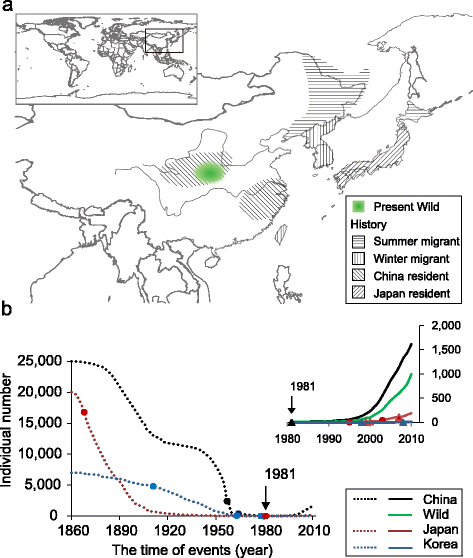
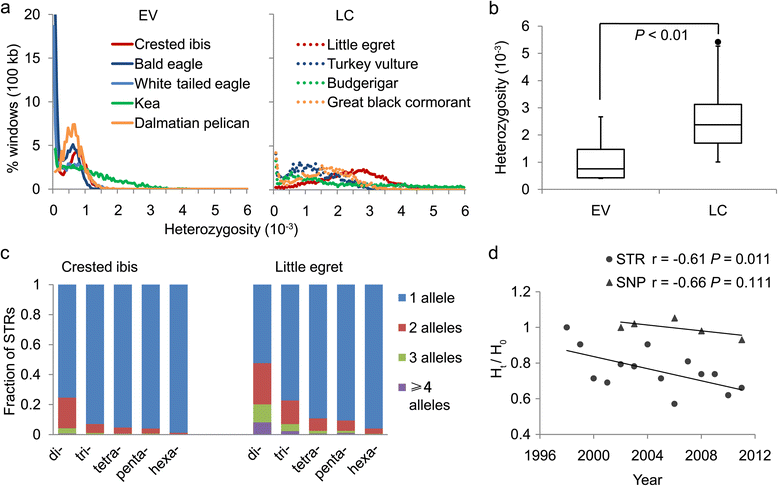
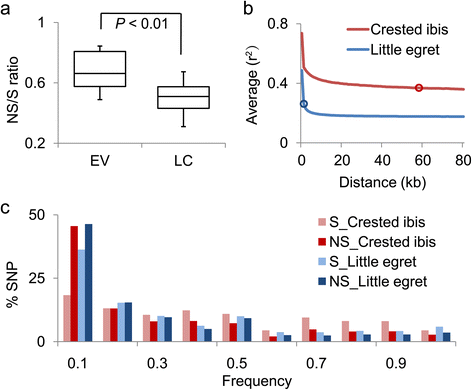
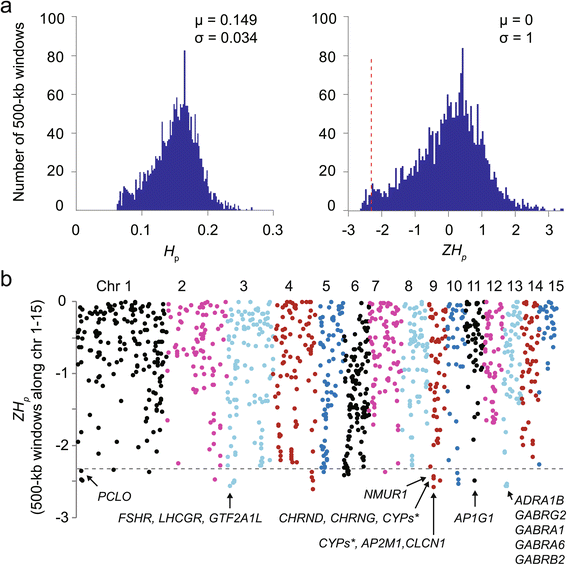
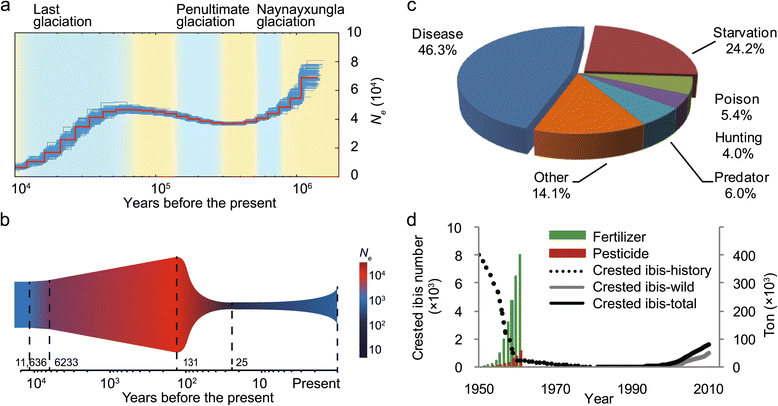
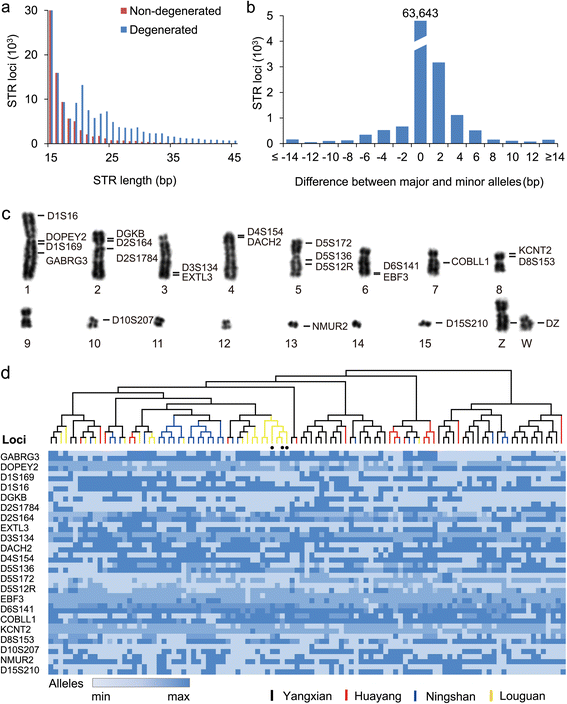
Similar articles
-
The Genomic Footprints of the Fall and Recovery of the Crested Ibis.Curr Biol. 2019 Jan 21;29(2):340-349.e7. doi: 10.1016/j.cub.2018.12.008. Epub 2019 Jan 10. Curr Biol. 2019. PMID: 30639104 Free PMC article.
-
Improved molecular assay for sex identification of the endangered crested Ibis (Nipponia nippon) based on the CHD1 gene and a sex-linked microsatellite locus.Zoolog Sci. 2013 Sep;30(9):742-7. doi: 10.2108/zsj.30.742. Zoolog Sci. 2013. PMID: 24004080
-
Molecular cloning and biochemical analysis of tyrosinase from the crested ibis in China.Biochem Genet. 2012 Dec;50(11-12):936-45. doi: 10.1007/s10528-012-9533-1. Epub 2012 Sep 19. Biochem Genet. 2012. PMID: 22990953
-
A Bird's-Eye View of Endangered Species Conservation: Avian Genomics and Stem Cell Approaches for Green Peafowl (Pavo muticus).Genes (Basel). 2023 Nov 4;14(11):2040. doi: 10.3390/genes14112040. Genes (Basel). 2023. PMID: 38002983 Free PMC article. Review.
-
Conservation genomics of threatened animal species.Annu Rev Anim Biosci. 2013 Jan;1:261-81. doi: 10.1146/annurev-animal-031412-103636. Epub 2013 Jan 3. Annu Rev Anim Biosci. 2013. PMID: 25387020 Review.
Cited by
-
Transcriptome Comparison Reveals Key Components of Nuptial Plumage Coloration in Crested Ibis.Biomolecules. 2020 Jun 15;10(6):905. doi: 10.3390/biom10060905. Biomolecules. 2020. PMID: 32549189 Free PMC article.
-
Avian W and mammalian Y chromosomes convergently retained dosage-sensitive regulators.Nat Genet. 2017 Mar;49(3):387-394. doi: 10.1038/ng.3778. Epub 2017 Jan 30. Nat Genet. 2017. PMID: 28135246 Free PMC article.
-
Draft Genome of Akame (Lates Japonicus) Reveals Possible Genetic Mechanisms for Long-Term Persistence and Adaptive Evolution with Low Genetic Diversity.Genome Biol Evol. 2024 Aug 5;16(8):evae174. doi: 10.1093/gbe/evae174. Genome Biol Evol. 2024. PMID: 39109913 Free PMC article.
-
Whole genome and transcriptome maps of the entirely black native Korean chicken breed Yeonsan Ogye.Gigascience. 2018 Jul 1;7(7):giy086. doi: 10.1093/gigascience/giy086. Gigascience. 2018. PMID: 30010758 Free PMC article.
-
Will human influences on evolutionary dynamics in the wild pervade the Anthropocene?BMC Biol. 2018 Jan 15;16(1):7. doi: 10.1186/s12915-017-0476-1. BMC Biol. 2018. PMID: 29334950 Free PMC article. Review.
References
-
- Attenborough D. Help us build a brighter future: the need to save the world’s most threatened birds. Cambridge: BirdLife International; 2008.
-
- Collar NJ, Andreev AV, Chan S. Threatened Birds of Asia: The BirdLife International Red Data Book. 5. Cambridge: BirdLife International; 2001.
-
- Frankham R. Genetics and extinction. Biol Conserv. 2005;126:131–140. doi: 10.1016/j.biocon.2005.05.002. - DOI
-
- Saccheri I, Kuussaari M, Kankare M, Vikman P, Fortelius W, Hanski I. Inbreeding and extinction in a butterfly metapopulation. Nature. 1998;392:491–494. doi: 10.1038/33136. - DOI
Publication types
MeSH terms
Substances
LinkOut - more resources
Full Text Sources
Other Literature Sources

